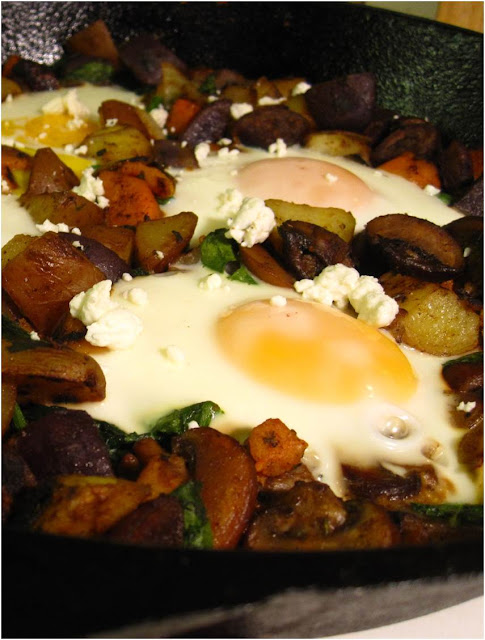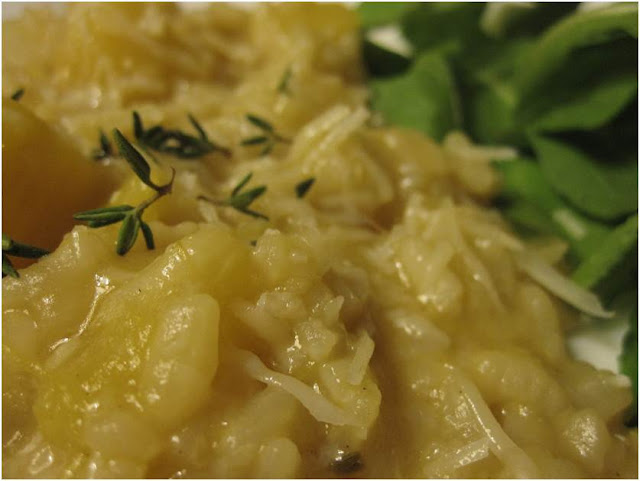The amount of meals I eat that are not cooked inside my home is at an all time low these days. I look forward to cooking, trying new ingredient combination at home, taking my dorky little pictures and writing my silly little stories. This weekend though I ate out three times - and I loved every minute of it. Two of those time were at the same restaurant, Trattoria, an Italian restaurant in Kitsilano. Friday night Mike and I thought we were meeting Mike's parents for dinner, however an as yet unsolved miscommunication occurred, placing us there on the wrong day. It was a busy Friday day so it was nice to arrive at the restaurant and unwind with a glass of wine. When we realized we had mixed up the date we opted to stay and eat. That evening, I ate an incredible pizza topped with squash, carmelized onions and gorgonzola; it was truly amazing.
We returned to the restaurant the next night, the proper parent-meet night, and I decided to try the risotto which also happened to be a squash and gorgonzola dish with spiced walnuts. I had never tried risotto at a restaurant before and did not know what to expect. It turned out to be really good; it was creamy and al dente at the same time. When I make risotto I never make it al dente but I can see the appeal. As a side dish to share we ordered what turned out to be a magnificent brussel sprout, chestnut and balsamic recipe. I was surprised at how delicious it was, probably one of the most unexpectedly tasty things I have tried in recent history.
A friend of mine has also organized for myself and a couple of friends to take on a community garden plot in Vancouver. Sunday morning was our first day out to the garden for a 'work party' which we spent working on common garden tasks such as weeding the paths and picking up garbage. It was pouring rain that morning, I was soaked and chilled to the bone after an hour, but it was fun to pick our plot (if we get the one we want we will be right under an eagles nest!) and also nice to be up and out-and-about on a Sunday morning. After the garden party we went for brunch at Slickity Jim's, a breakfast place on Main street. This establishment recently relocated south on Main street after a fire closed down their old location.
The only thing I cooked this weekend was this salad which turned out very flavorful and satisfying; I liked the addition of the apple which added a nice sweetness. It is best eaten right away, while still warm but if you do store it and eat it later it is best with some freshly squeezed lemon juice or soft goat cheese. You probably don't need to use all of the spices I did. My motivation behind the selection was basically that I wanted to try grinding some spices in my new mortar and pestle. Is that not a good enough reason?
Roasted potato, squash and apple salad
Winter seasonal: squash, apple and potato
Ingredients
1/2 delicata squash, peeled and chopped in cubes
8 red new potatoes, chopped
1 tbsp grape seed oil
2 tsp curry powder
Sea salt
3 garlic cloves, crushed
2 small apples peeled, cored and cubed
1 tbs grapeseed oil
1 tsp honey (agave or maple syrup for vegans)
2 cups cooked chickpeas
1/2 tsp black mustard seeds
1/2 tsp yellow mustard seeds
1/2 tsp cumin seeds
2 pods cardamom
2 cups spinach, chopped
Meyer lemon zest and juice
Directions
1 - Preheat oven to 400F
2 - Bring salted water to boil in a pot, add chopped potatoes and boil about 5 - 6 minutes. Drain well.
3 - In a ovenproof dish toss potatoes and chopped squash with oil, curry powder, garlic cloves and sea salt. Alternatively you can spread on a baking sheet. This depends on whether you like your vegetables softer (in a baking dish) or more dry and crispy (baking sheet).
4 - Toss apple pieces in a tsp of oil and with honey - add to potatoes and squash or place in a separate dish.
5 - Roast vegetables and fruit about 30 - 40 minutes until cooked through and lightly browned. Turn/mix once or twice.
6 - Meanwhile, roast spices (mustard seeds through cardamom seeds) in an iron skillet or pan until aromatic, about 5 minutes. Grind spices with a mortar and pestle.
7 - Turn up the heat in skillet to medium high heat. Mix chickpeas with spices and brown lightly in the skillet for a few minutes.
8 - Removes vegetables from oven and let cool a couple of minutes.
9 - Mix vegetables and apple with chickpeas and spinach.
9 - Mix vegetables and apple with chickpeas and spinach.
10 - Serve salad topped with freshly squeezed meyer lemon (or regular lemon) juice and grated zest. Soft tangy goat cheese is also a nice topping.






























